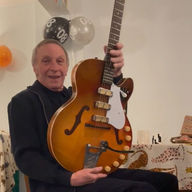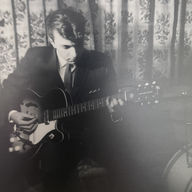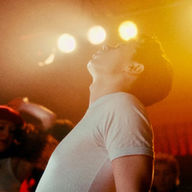1964 Harmony Rocket H59 III, as made famous by Billie Joe Armstrong
Hardly in the minority, there were more Harmonys produced in the 60s than Gibsons and Fenders. Now a favourite of indie explorers seeking retro mojo - and Billie Joe Armstrong's choice for Green Day crowd-pleaser Minority: "Without a doubt, singled out, the only way I know."
If you haven't heard of them, Harmony made musical instruments. A lot of them. Really a lot. 350,000 at their peak in 1964 - 65. A time of mass production when they overshadowed Gibson and Fender put together. In fact, over 30 years, they built about 10 million guitars. 10 million guitars! Yet, by 1975, they missed the writing on the wall, and found themselves closing down as cheaper, equal (or higher) quality foreign-built instruments started to flood the market. A sadly familiar story.
Until that point, for the beginner or intermediate guitarist, Sears catalogue in hand, Harmony held the keys to the fame and fortune that every budding guitarist craved. And they went out of their way to cater to that emerging market, with a vast range, all shapes and sizes: solid-body, semi-acoustic, acoustic, bass, not to mention a small line in amps. Total mass production for an avid public.
I don't know what's happened to those 10 million guitars today. Weirdly, you don't often see a Harmony on the market. But you do see them every once in a while in the hands of guitarists known for their retro mojo: Dan Auerbach, Billy Corgan, Wayne Coyne. And, on Minority, the ultimate anti-hero anthem, live with Green Day's Billy Joe Armstrong. Check the link below.
This one (like so many others) may have had its Cherry Sunburst fade to a glorious Honeyburst, but it still delivers in spades. Plays brilliantly. It will even give you a Tele twang in the all-pick-up mode - how, I don't know, but it does. A unique piece of the 60s, and a blast to play.
See & Hear It In Action
-
Minority, Green Day, Live in Porto Alegre (2010): Billie Joe Armstrong, an H59, a punk anthem, and a stadium of jubilant Brazilians. It doesn't get much better than this.
-
Mike Dugan Playing Drowning In Guitars' 1963 Rocket H59: Demos don't come much better than this. The hugely talented Mike Dugan puts Drowning In Guitars' H59 through all pick-ups, clean and overdriven. Everything you could wish for!

Feedback
Specification
Make
Harmony Rocket
Model
H59
Colour
Cherry Red Sunburst, faded to Honey on top
Year
1964
Serial Number
N/A
Number of Frets
20
Fretboard
Ebonised Maple
Neck
Poplar
Body
Maple
Tuners
2 x 3-on-plate open gear
Pick-ups
DeArmond Golden Tone "Indox" S-Grille soapbars
Bridge
Rosewood floating height-adjustable bridge
Tailpiece
Bigsby "Made Under Licence" Vibrato
Scale Length
24.25"
Full Length
39.8"
Further Information:
-
The Rocket series launched in 1959, and ran for 8 years. Offered in four variants, from single, to double, to triple pick-ups, they were targeted at beginner to intermediate players, with relatively budget prices to match. In 1964, you could pick-up this three pick-up version for just $154.50.
-
Why a 1964? Harmony didn't give serial numbers to their guitars at the time. Easy to imagine that would be deemed an unnecessary inefficiency on a mass production line. Fortunately, the pick-ups are clearly stamped: March 9 1964, to be precise. And we know that the Steel-Reinforced neck that this one comes with was replaced by an adjustable truss rod late in 1964.
-
Originally, the H59 came with a standard trapeze tailpiece. You can see the original screwholes around the back strap button. Early on, someone in their wisdom fitted a Bigsby tremolo - so early that the original cherry sunburst on the body top shines bright and clear when you lift the Bigsby up. It's a "Made Under Licence" Bigsby, which, as I understand it, means that it's diecast and lighter, rather than sandcast and heavier (and subject to a lot of "which is better?" debate on the web). Whatever, it plays beautifully. Lovely smooth vibrato, no slips, creaks or detunes. Just perfect.
-
The only other mod is the replica pickguard which I've added. Another clue to mass production efficiencies: the wires to the pick-up selector switch are body-mounted, rather than threaded through the hollow-body. So a pickguard serves more than its usual purpose. The original pickguard would have had a Harmony logo at the bridge-end. Yet, for all the volumes that Harmony produced, an original H59 guard seems to be a holy grail. If anyone has one for sale, contact me!
-
Soundwise, it's a blast. Those Rowe Industries DeArmond soapbar pick-ups are an absolute joy. Surprisingly distinct tone as you switch between each. Even more surprising the near-Tele twang you get when you switch to all three on at once. And with that completely hollow body, there's more than enough opportunity for waves of controlled (and uncontrolled) feedback.
-
All in all, this is one truly versatile instrument. It may have been part of a batch of 350,000 instruments in the year it was built, but it's as unique as they come and a blast to play. Worth your time, and some!
Sources & Links
-
Vintage Guitar & Bass: Always the best place to start, Vintage Guitar & Bass provide the perfect introduction to the Rocket range.
-
"A Perfectly Good Guitar": A fabulous and loving story behind the Rocket H59, in this case, a 1963. Thanks to Drowing In Guitars for the insights. And, by the way, if you want to see a proper warehouse grade guitar collection, this is the place to go. Called Drowning In Guitars with good reason!
-
The Harmony Database: If you like your Harmonys, then there can be no better site than this to explore the full range. The site's creator, Francois Demont, has sadly passed away, but the legacy he has left is exceptional. The Harmony Database has loads to meet all the needs of any Harmony fan. Super source.
-
DeArmond Pick-up Database: You're unlikely to need this very often, but if ever you need to identify your DeArmond pick-ups, this site from musicpickups.com is gold-dust. Another super reference.





















